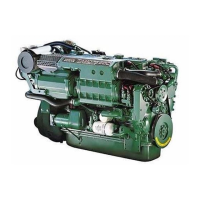29
Operation
Emergency shifting
If shifting is not possible with the control, the Twin Disc
and ZF gears (intended for electronic shifting) can be en-
gaged manually for forward movement. See the “Trouble-
shooting” chapter for additional information.
If the boat has more control positions, it may be pos-
sible to operate the reverse gear from this/these.
Forced propeller rotation
(E.g. when towing)
When towing, sailing, anchoring in strong currents, etc.,
the propeller can make the propeller shaft rotate even
though the engine is stationary. This rotation may be un-
comfortable and can damage the reverse gear.
IMPORTANT! The propeller shaft can be allowed to
rotate with a stationary engine for up to 6–8 hours.
After that period, the engine must be started and run
for at least 5 minutes to enable lubrication and cooling
of the reverse gear.
In cases where the propeller shaft may rotate faster than
during normal operation, e.g. when sailing, a temperature
gauge should be fitted to monitor the oil temperature. Max.
permitted temperature is 110°C (230°F) for Twin Disc and
95°C (203°F) for ZF reverse gear.
A shaft brake must be fitted if the above directions cannot
be followed or if it is necessary to stop the shaft for rea-
sons of comfort. On isolated occasions, the propeller shaft
flange can be locked mechanically in a suitable manner.
Accessories
Flush and bilge pump
The bilge pump has a vacuum switch (1) that automatically
disengages the pump when water is no longer being drawn
into the pump.
The scavenging and bilge pump is engaged and disen-
gaged from a switch that is normally located at the main
control position. The bilge pump can also be engaged
manually by holding down the lever 2 for about 20 sec-
onds.

